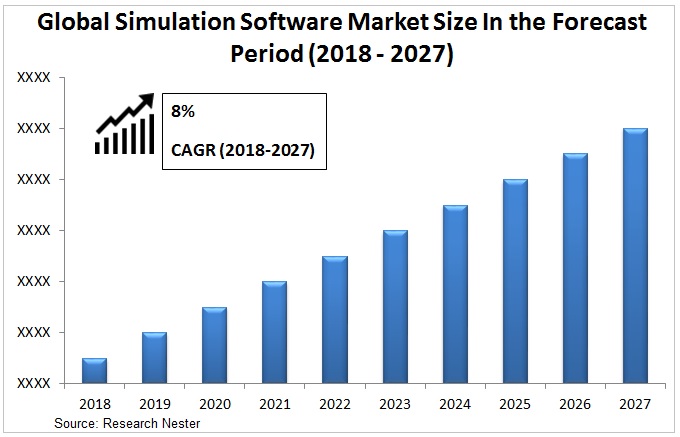Simulation Software Market Trends
Growth Drivers
- Rising demand for effective software solutions to reduce production and training costs - The market for simulation software is expanding quickly due to the rising need for effective solutions to reduce training and production costs. These advanced tools enable companies to simulate real-world situations, pinpoint operational inefficiencies, and test novel concepts in a risk-free setting.
By using this strategy, businesses can improve overall performance and productivity while cutting production and training costs dramatically. This prevalent pattern emphasizes how simulation software is becoming more widely acknowledged as a priceless tool for contemporary companies looking for data-driven, cost-effective solutions. As a result, the simulation software market is anticipated to rise. - Utilizing cutting-edge technologies in simulation tools to drive market expansion - The use of simulation software is growing in popularity across several business sectors. Organizations can use the tool to simulate different scenarios, analyze and optimize performance, and determine the need for predictive maintenance. Artificial intelligence and machine learning techniques are becoming more common, and they are being included in simulation programs to improve predicting talents, streamline procedures, and enhance models.
Large volumes of simulation-generated data may now be analyzed by AI-powered algorithms, helping enterprises make data-driven decisions, obtain new insights, and enhance overall simulation performance. Furthermore, to create immersive and engaging experiences, simulation tools are being merged with virtual reality (VR) and augmented reality (AR) technology. There are estimated to be over 2 billion active AR-user devices by 2023. And in 2024, that amount is projected to rise to over 16 billion. With the help of these technologies, users can engage in and visualize simulation more naturally and entertainingly. Therefore, the simulation software market is predicted to experience a surge. - Increasing need for production plants to reduce risk and make smart decisions- Businesses may enhance the overall safety and dependability of their goods, optimize designs, and make well-informed decisions by modeling real-world scenarios and analyzing data.
Additionally, without having to pay extra money, the tool lets companies test out various design configurations, materials, and operational conditions. This adaptability promotes innovation, speeds up product revisions, and fosters creativity. By minimizing material waste and streamlining production processes, the tool also benefits a variety of different industries. Hence, the revenue for the market is poised to grow.
Challenges
- Lack of standards and guidelines - The market for simulation software lacks standard operating procedures, which makes it difficult for companies in different industries like engineering, healthcare, and gaming to collaborate. Different software designs and data formats cause problems with data accuracy, increased expenses, and inefficient use of resources by interfering with smooth integration and resource allocation.
In addition, the lack of benchmarks makes tracking progress and evaluating performance more difficult. To resolve these problems, cooperative efforts are required to create industry standards that improve coherence, encourage innovation, and increase compatibility within the market. - High initial deployment cost is attributed to impeding market growth.
- Data security is becoming a bigger issue, and software integration is getting harder.
Simulation Software Market: Key Insights
The simulation software market is witnessing robust growth during the forecast period. The increasing technological development coupled with rising demand from various end-user industries is expected to be major reason for the growth of the simulation software market during the forecast period. Additionally, the high application of simulation software in automotive industry reduces the manufacturing cost which indirectly drives the market growth of the simulation software. Moreover, the advent of technologies such as artificial intelligence and robotics is also expected to fuel the market growth of the simulation software over the forecast period.imulation software market is anticipated to expand at a CAGR of 8% over the forecast period. The market is expected to attain a total value of USD 18 billion by 2027.
The market is segmented on the basis of software, services and end-use industry. On the basis of software, it is sub-segmented into on-premise and cloud. On-premise is anticipated to be the leading sub-segment during the forecast period. The high application of on-premise deployment in various end-use industries is major reason for the growth of the sub-segment. However, cloud based sub-segment is expected to register highest CAGR during the forecast period. On the basis of services, it is sub-segmented into consultancy, training and others. On the basis of end-use industry, it is sub-segmented into automotive, aerospace & defense, healthcare, semiconductor and others.
Automotive is anticipated to be the leading sub-segment during the forecast period. The high application of simulation software in design of various parts of automotive components is expected to be a major reason for the growth in sub-segment. For instance, according to Indian brand equity foundation, the total number of automobile produced was 24 million in 2016 and it is to grow by 29 million in 2018.
High adoption in various end-use industries
The high adoption of simulation software in various end-use industries is anticipated to be a major driver for the overall market during the forecast period. Aerospace and defense has the high application of simulation software as it enhances the safety and security of military personnel.
Widespread Technological Advancement
The increasing technological development coupled with the advent of big data is driving the simulation software market. The technological development is expected to enhance the features associated with simulation software .It increases the scalability and reduces the complexities associated with software.
|
Base Year |
2024 |
|
Forecast Year |
2025-2037 |
|
CAGR |
13.4% |
|
Base Year Market Size (2024) |
USD 20.05 billion |
|
Forecast Year Market Size (2036) |
USD 102.82 billion |
|
Regional Scope |
|

